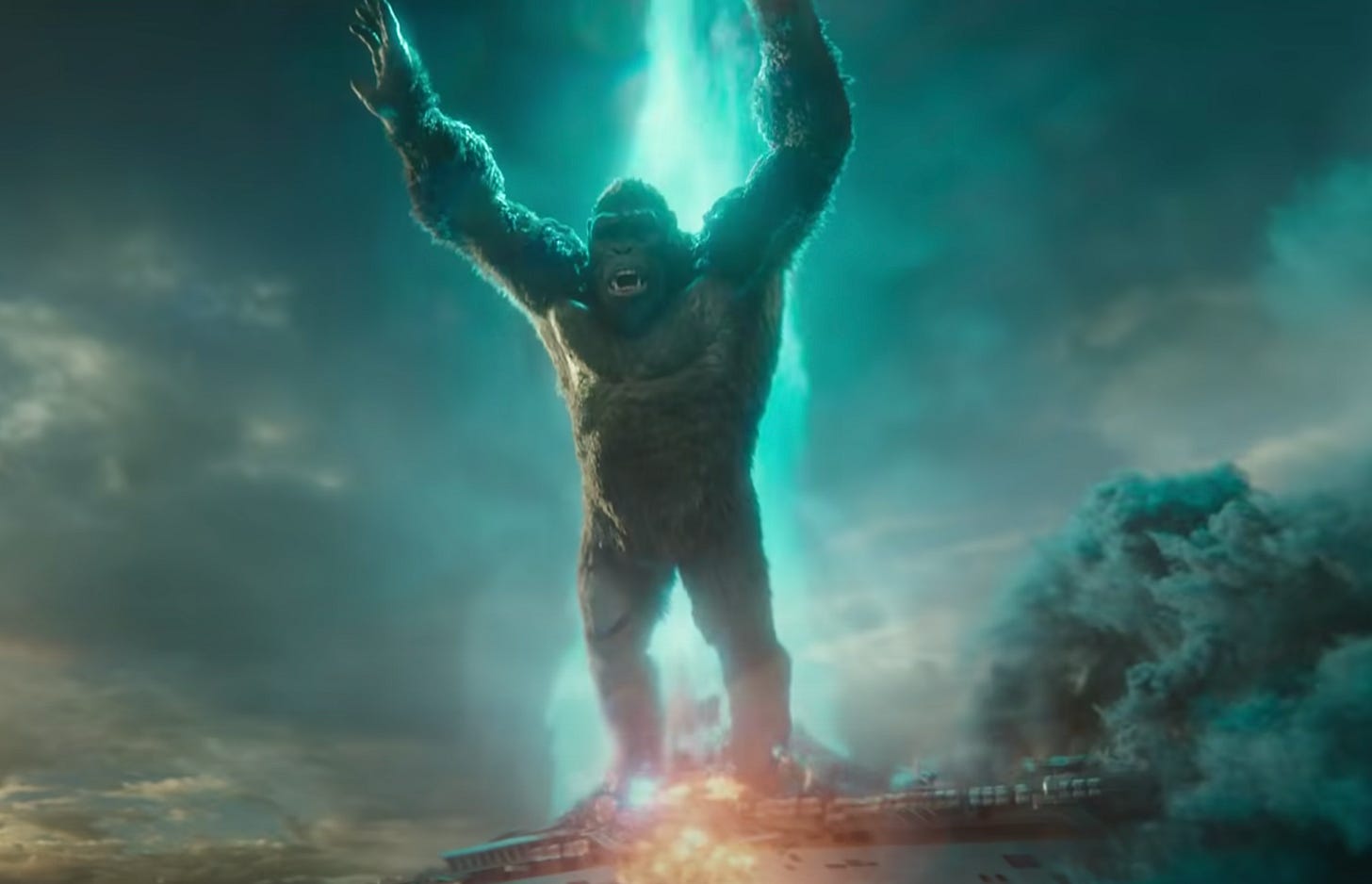'Godzilla vs. Kong' Lives Up to Its Legacy | Review
Let them fight.
It’s been nearly seven years since Hollywood’s latest iteration of Gojira, the legendary kaiju of Japanese cinema, debuted to strong box office returns, respectable reviews, and apparent indifference from audiences. Despite its enormous opening weekend, Godzilla (2014) seemed to fade quickly, doing well enough to justify sequels and spinoffs but hardly inspiring the widespread enthusiasm a character of Godzilla’s stature typically does.
Over the years, there has undoubtedly been a love/hate relationship between audiences and the 2014 film. Some would describe it as an awe-inspiring spectacle that smartly updates the thematic underpinnings of the 1954 original while using modern technology and aesthetics, along with Spielbergian storytelling cues, to give the kaiju the God-like reverence they deserve. Others wrote it off as a visually inscrutable bore, with too many pointless characters and too little carnage.
In response, the MonsterVerse did what most modern franchises have done: treat each new installment as a referendum on the previous installment. Was the last one too dark? Kong: Skull Island (2017) and Godzilla: King of the Monsters (2019) — directed by Jordan Vogt-Roberts and Michael Dougherty, respectively — drip with bold colors. Too many bland humans? Here’s a cadre of fun actors and who can quickly breathe life into thin characters. Not enough monster action? Both films feature a bevy of foes - Skullcrawlers, Mothra, Rodan, and King Ghidorah — to satiate anyone’s appetite for destruction.
And still, audiences didn’t seem to care. While Kong: Skull Island was relatively well-received, even earning an Academy Award nomination for its visual effects, it never made an impact in the wider discourse. (Maybe that’s a side effect of living in a Marvel world.) Then, Godzilla: King of the Monsters was vilified. Audiences and critics complained that the movie was too loud, too silly, and (somehow) visually inscrutable. The movie ended up losing money and the fate of the MonsterVerse was now in jeopardy.
The history of the franchise is important because the culmination of all this, Adam Wingard’s Godzilla vs. Kong, is finally here. After several delays resulted in a day-and-date streaming release, that there’s any anticipation for the film is a small miracle. But there does seem to be genuine excitement to see these two behemoths share the screen for the first time in 59 years (1962’s King Kong vs. Godzilla). And as someone who’s enjoyed all three of the franchise’s previous installments — each one is good in different ways — I’m glad to say that Godzilla vs. Kong was worth the wait.
I won’t summarize the plot. I will say that, in broad strokes, the movie continuously surprised me. Even with my usual practice of avoiding trailers, I had surmised that a certain character would make a third-act appearance and that Kong, at some point, would acquire a weapon. (It glows blue when Godzillas are close.) But the movie’s subversiveness is on display from the very first scene, which uses sound and music to provide a largely dialog-free re-introduction of Kong.
The screenplay, credited to Eric Pearson and Max Borenstein, sets up a believable conflict between the title characters; its simplicity is what works. This leads to no fewer than two fights between Godzilla and Kong, both of which are ended decisively. Along the way, there are journeys all around — and into — the Earth. Wingard wears his inspirations on his sleeve, referencing various masters like Peter Jackson, Ray Harryhausen, Stanley Kubrick, and Terrence Malick. The film’s diverse array of inspirations may sound messy, and could easily have come off that way, but the final product works as a surprisingly cohesive whole.
In many ways, this is Kong’s movie, and the screenplay is structured to make him the protagonist. He’s the character we meet first, he’s the character who goes on an odyssey of self-discovery, and the movie’s final moments are about him. However, this tends to make Godzilla one-dimensional. After being portrayed as a reluctant protector in the 2014 and 2019 installments, Godzilla becomes a mindless brawler for much of this film. It’s not a huge issue, and there’s a diegetic justification for Godzilla’s portrayal, but it robs the character of his personality.
Godzilla vs. Kong’s human characters, for the most part, are well-cast and well-integrated. The sole misstep is a subplot that follows Millie Bobby Brown, Bryan Tyree Henry, and Julian Dennison. Their storyline is admittedly necessary and features one of the better moments in the movie (a certain character’s introduction), but feels like something from the Disney Channel.
The visual effects are convincing and the sound design is often extraordinary, especially when dealing with a particular character who’s deaf. Cinematography is fine; there’s a lot of trendy orange, teal, and neon lights, but the action is shot clearly. Editing is good, with the movie clocking in at about 100 minutes before credits. The score — by Tom Holkenborg/Junkie XL, of Mad Max: Fury Road and Batman v Superman: Dawn of Justice fame — is serviceable, but the source cue selection is excellent.
One way the movie works so well is that it functions as both a definitive conclusion and a temporary pit stop. If no more sequels follow, that’s fine; the four-film arc has played itself out to a conclusion. But more could easily be made if Toho, Legendary, and other partners see financially fit. The fickleness of modern audiences makes predictions difficult. I’d love to see more, but I wouldn’t be surprised if the MonsterVerse closes shop.
And that would be a shame because this franchise has been one of the most consistently dependable of the last decade. These films know exactly what they are and they deliver exactly what they should be expected to. Godzilla vs. Kong is the summation of all the MonsterVerse has ever been: unexpectedly beautiful and unequivocally satisfying.




